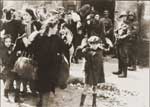Warsaw Ghetto
Photograph
IN 1943 THE GERMANS cleared and erased the Ghetto in Warsaw,
Poland, after an armed Jewish uprising.
 THE
German police commander Jürgen Stroop donated an
album of 49 photographs of the brutal operation to
Heinrich Himmler, the Reichsführer of the SS,
entitled THE WARSAW
GHETTO IS NO MORE. The album was
captured by the Allies and introduced in the Nuremberg
Trials as an exhibit. With the 76-page German report, the
album
has been scanned in its
entirety and posted on the Web on March 25, 1998 by
Jamie
McCarthy, to whom gratitude is
due. The most famous photograph is that reproduced above.
[Click the picture for a larger scan].
[More,
in German]
THE
German police commander Jürgen Stroop donated an
album of 49 photographs of the brutal operation to
Heinrich Himmler, the Reichsführer of the SS,
entitled THE WARSAW
GHETTO IS NO MORE. The album was
captured by the Allies and introduced in the Nuremberg
Trials as an exhibit. With the 76-page German report, the
album
has been scanned in its
entirety and posted on the Web on March 25, 1998 by
Jamie
McCarthy, to whom gratitude is
due. The most famous photograph is that reproduced above.
[Click the picture for a larger scan].
[More,
in German]
- What happened to the German soldier with the gun? Who was he? It is believed that he was identified living in the Soviet zone of Germany about twenty years ago, and executed. Answers: Wolfgang Leander suggests on Sunday, September 4, 2005 that his name was SS Rottenführer Josef Bloesche: "You want to know who the SS-soldier on that famous photograph is? Read the book "Der SS Mann - Josef Bloesche, Leben und Sterben eines Moerders" (Website comment: In fact this is a 2004 ARD film by Heribert Schwan). Bloesche (Blösche) was guillotined by the communists in 1969.
- Who is the frightened
little boy with his hands
raised in the air? It is known that he survived the
war.
One answer: On May 28, 1982 the New York Times quoted Dr Tsvi C Nussbaum, a physician living in Rockland County in upstate New York, USA, as claiming to be the then seven-year old youngster. He recalled that there had been persistent rumours that the Nazis were planning to exchange Jews for German citizens living abroad. Nussbaum and other Warsaw Jews thereupon emerged from their hiding places and surrendered to the Nazis. Their names were indeed, he said, put on a "Palestine list", and he was sent to the Bergen-Belsen concentration camp in Germany, from which he was liberated by British troops in 1945. He spent the next eight years in what became the state of Israel, and emigrated to New York as a doctor in 1953. "I remember there was a soldier in front of me," he told the newspaper, recalling the picture, "and he ordered me to raise my hands." After his uncle intervened, he was allowed to rejoin his family.
The discovery that the boy was not liquidated, as had been popularly believed, caused outrage and consternation among holocaust scholars who were convinced, said the New York Times, that "the symbolic power of the picture would be diminished were the boy shown to have survived." These historians had long considered the picture "a sort of sacred document," added the newspaper. Dr Lucjan Dobroszycki, of New York's well-known Yivo Institute of European Jewish History, echoed this, proclaiming that this picture of "the most dramatic event of the holocaust" required "a greater level of responsibility from historians than amost any other." "It is too holy," he added, to let people do with it what they want." Nussbaum was shocked at this unexpected reaction to his survival: "I never realised that everyone puts the entire weight of six million Jews on this photograph," he said. "To me it looked like an incident in which I was involved -- and that was it." - Website Axis History states: "The little girl on the left has been identified as Hanka Lamet, who is standing next to her mother, Matylda Lamet Goldfinger (the woman second from the left). The boy carrying the sack has been identified as Leo Kartuzinsky and the woman in the front has been identified as Chana Zeilinwarger. Numerous people have identified the boy in the foreground as either Arthur Domb Semiontek, Israel Rondel, Tsvi Nussbaum or Levi Zeilinwarger, but none of these identifications can be conclusively corroborated."
- Can anybody provide further further information about people shown in the picture?